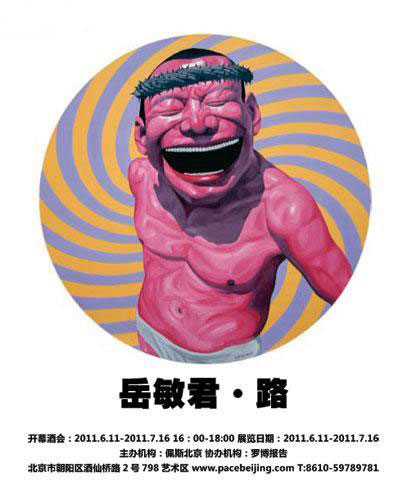[T]he Pace Gallery, Beijing presents an exhibition of Yue Minjun's recent works in cooperation with Robb Report. The exhibition, entitled The Road, is the leading Chinese contemporary artist's first solo exhibition in the Pace Gallery, Beijing. The exhibition is on from June 11th through July 16th. More than two decades into his artistic career, Yue is still smiling at the world as he sees it. His trademark “Smile” symbol, the playful, mocking hallmark of the artist's cynical realist style, conceals within it a spirit that's sometimes stubborn and fragile. By mocking his subject's nihility, he stands apart from - and in judgement of - it in a unique way. Despite the world changing around him, Yue's distinctive style hasn't changed much. So should our understanding of his work change? If the object of the “Smile” has changed, should there be some shift in the feel of the "Smile" itself? Or could it be that nothing changed at all?
In his newest exhibition, Yue's work takes on Christian forms. The strength of Western culture has pushed more than a few Chinese people into an existence stripped of its cultural core, making them into nomads, wandering in the space between two cultures. By altering the semantic relationships between the people and space in the original works, the works seem almost to dissolve away, neatly avoiding the contradictions and embarrasment inherent to any collision between two cultures. As the curator Leng Lin stated, “Confronted with something you don't completely understand, a smile can mean rejection, or confusion. But it can also mean inclusion and acceptance.”

Yun Minjun The Road 01

Yun Minjun The Road 02

Yun Minjun The Road 04

Yun Minjun The Road 03
Yue Minjun
Yue Minjun (b. 1962, Heilongjiang, China) has been quoted as saying he “always found laughter irresistible.” Best known for his oil paintings depicting himself with his trademark smile, Yue is a leading figure in the Chinese contemporary art scene. He has exhibited widely and is recognized as one of the breakout stars of his generation. The artist currently lives and works in Beijing.
In his earlier work, surrealism had an especially strong influence on him. His self-portraits from the 1990s were the first to depict his easy, automatic smile, but the figures warmth masked underlying emotions. The smile became a mask as the paintings’ complexities were played out in the figures’ arrangements or poses. His work became further influenced by western art history as he began arranging his figures in poses or settings reminiscent of the masterpieces.
Yue has also been continuing his Scene series in which his removes figures from historical Chinese socialist paintings and well-known western paintings. “In typical socialist paintings in China looked very realistic but were indeed surreal. They served for heroic fantasies, and the images of great people or the heroes in the paintings could well justify the fabricated scenes.”
Yue Minjun has shown internationally including The Archeological Discovery in AD3009 at ARoS Aarhus Kunstmuseum, Aarhus; Half-life of a Dream: Contemporary Chinese Art from the Logan Collection at San Francisco Museum of Modern Art, San Francisco; solo museum exhibition Yue Minjun and the Symbolic Smile (2007 – 2008) at Queens Museum of Art, Queens, New York; The Reproduction of Idols: Yue Minjun Works, 2004-2006 (2006) at the He Xiangning Art Museum, Shenzhen, China. He has also been included in the 2008 and 2004 Shanghai Biennales, and the 48th Venice Biennale, Venice (1999).




























